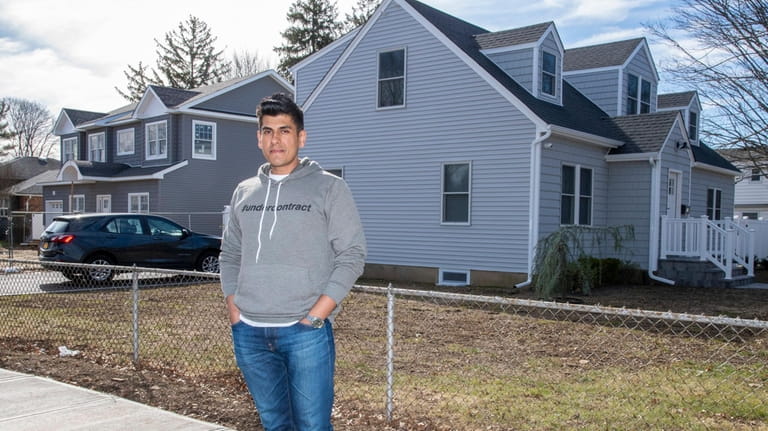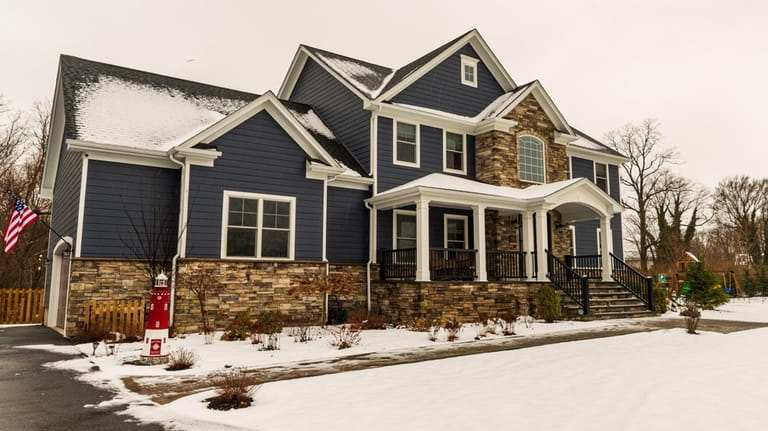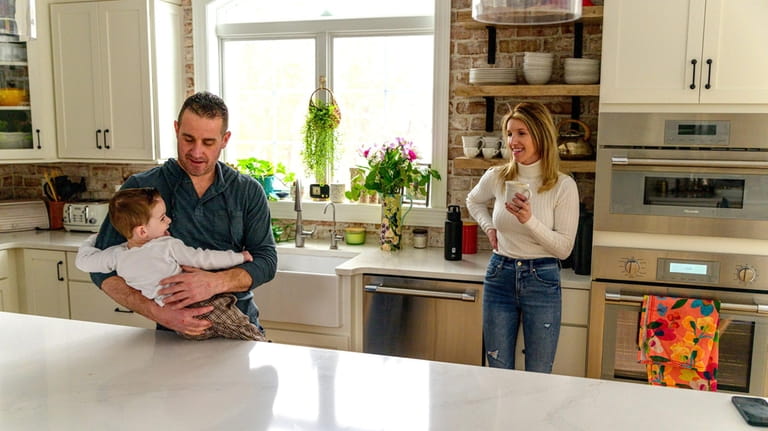Is it cheaper to buy or build a house on Long Island?
When it came to deciding which type of home to buy — brand-new, newish or vintage — Juan Castro chose the fix-it-yourself route, purchasing a circa-1930 three-bedroom, 1½-bath brick Cape last March for $570,000.
Acting as the general contractor and, except for electrical and plumbing work, doing much of the work himself, Castro did a gut renovation of the Floral Park home, for an additional $120,000 — $20,000 over his original budget of $100,000.
There are many factors to ponder when buying a home or building a new one, from budget to time, convenience, aesthetics and energy efficiency, among other considerations.
"In order to be within our price range and to get a house to the way that we wanted it, the only way to do it would be to buy something that needed everything redone," said Castro, 35, who owns a landscaping business.
Juan and Ecem Castro purchased their home in December and renovated it for $120,000. Credit: Johnny Milano
Nine months after closing, the Castros moved into their home, which now has two bedrooms, two full bathrooms, a newly created dining room and an open floor plan. "It's a completely different house, if you look at the before-and-after photos," Castro said.
Shahzad Qureshi, the real estate broker who sold the Castros their home, often helps buyers navigate the marketplace, particularly in deciding whether to buy or build.
Qureshi, who owns Syosset-based Pinnacle Real Estate Consulting, builds between five and six homes a year.
"We buy a house, we knock it down, we build a new house and usually we sell it during construction or soon thereafter on a speculative basis, meaning you build it, you design it, you hope to sell it at some set price for a profit, as opposed to being a custom builder that does design and build work for homeowners," explained Qureshi, who is creating a subdivision on a corner lot in Plainview, with a restored 1940s farmhouse and a new 3,000-square-foot, five-bedroom Colonial.
A prepared buyer with a budget
Before and after shots of the Castros' bathroom. Credit: Johnny Milano
Back in the day, buyers relied on real estate agents for everything. Today, Qureshi observes, buyers come prepared.
"They've done their homework," he said. "They've spent countless hours on Zillow or Realtor.com. They know what their neighbors' houses are selling for. They know all the comps."
With buyers having a good sense of what they want in a home, the real estate agent's job is to educate them on the pros and cons of their impending decisions.
Being preapproved for a mortgage is a necessity, Qureshi said.
"It's generally a prerequisite to look at a house that you have a current preapproval, especially in a high-traffic listing," Qureshi said, noting that there were 1,968 homes for sale in Nassau and 2,211 in Suffolk as of March 13, according to One Key/MLS. "The demand is through the roof."
Budget sets the tone for which route people can take — whether they can afford new construction, a fixer-upper or a home that can be renovated over time, noted Qureshi.
"The most economical way to go about finding a home, especially in a tight supply market, is to find a good house that has been taken care of, has been updated through the years, but might need a bit of cosmetic work," Qureshi said, adding, "Buying at the right price sometimes requires a little bit of imagination."
Buying and renovating a home typically costs more than people realize, as the work is a lot more extensive and it's exceedingly difficult for owners to do general contracting when working full time.
"I've seen a lot of people make some big financial blunders by biting off more than they can chew," Qureshi said.
What does it cost?

Shahzad Qureshi, owner of Pinnacle Real Estate Consulting, renovated a rental house in Plainview. Credit: Rick Kopstein
Basing his figures on the dozens of homes he's either built or other builders with whom he's worked, Qureshi estimated the average price to build a new home on Long Island is $200 to $250 per square foot, not including additional costs for land, which vary from community to community. With approximately $50,000 in soft costs, including demolition, architect’s fees, insurance, permits, and new utilities added in, a 3,000-square-foot home could cost between $650,000 and $800,000 to build, plus an additional $500,000 to $700,000 for the land, totaling between $1.15 million and $1.5 million. Mike Florio, CEO of Long Island Builders Institute, concurred with Qureshi's figures.
In most areas of Nassau and Suffolk, based on recent sales, Qureshi estimated, an 1,800- to 2,400-square-foot, three- or four-bedroom split-level, high-ranch, or Cape in move-in condition will cost $700,000 and up. Excluding the Hamptons and the North Fork, prices drop somewhat for homes farther into eastern Suffolk, Qureshi added. With new construction, a 3,000-square-foot or larger, four-bedroom home will run between $1.2 and $1.3 million.
Often, people looking to build a home are also looking to trade up — to go from a smaller home to a considerably larger one, which adds to the expense, said Linda Freedman, of Douglas Elliman Real Estate.
Another factor to consider: new homes always come with higher taxes.
"The taxes will definitely increase when they're reassessed. It can take a year to two years until they get reassessed," said Freedman, noting that depending on which point in the construction a buyer comes on the scene, it could take a year or longer to complete a home.
Taxes on new construction will always go up because they’re based on the market value of the home, explained Adam Heller, founder of Heller & Consultants Tax Grievance of Rocky Point.
“On a newer home, the value is much higher, especially because the cost of everything has gone up: the cost of material, the cost of labor,” Heller said. “So, if the price of the new home goes up, then the assessment goes up.”
For Tazleem Khan, who was renting an apartment in Farmingdale with his family, paying more for a custom-built home in Plainview was the way to go.
'We like the fact that a new home kind of gives us that time to be able to enjoy the home without having to do all the little fixer-uppers...'
— Tazleem Khan
"We liked the location," said Khan, who bought the home while it was under construction. "It's right around the corner from a school our son will eventually go to," said Khan, who hired Qureshi to help negotiate the home's spec list, which outlines everything that’s included from the builder in the advertised list price.
Replacing a teardown, their new home on Newcastle Avenue is a 3,200-square-foot, five-bedroom, three-bath Colonial for which the Khans paid $1.2 million and moved into in December 2021.
During their search, Khan said they looked at the home market and didn't feel there was a "dramatic difference in the overall cost" between building and buying. "Therefore, we decided to invest a little more and go with something new: less problems, less long-term issues."
With a toddler at home, Khan, 40, and his wife, Priscilla Persaud, 38, who are both physicians, have little free time for home renovations.
"We like the fact that a new home kind of gives us that time to be able to enjoy the home without having to do all the little fixer-uppers that another home may require that we just don't have the time for," Khan said.
Building a dream home
Shahzad Qureshi is building a spec house in Plainview, next to a rental home he renovated. Credit: Rick Kopstein
Despite the higher price point, there are advantages to buying a newly constructed home.
With a new home, Qureshi notes, buyers have new water service, sewer or cesspool, mechanicals and roof, plus Energy-Star-rated air conditioning, heating, hot water, and the latest and most efficient insulation and windows. Other advantages: buyers get up-to-date design, including higher ceilings, an open floor plan, larger windows and closets, gas fireplaces and second-floor laundry. These are all mostly standard features that are either prescribed by law or follow the current marketplace, added Qureshi.
"And most importantly, a new construction bought from a reputable builder is backed by a New York state-mandated new construction warranty," said Qureshi, adding that the warranty covers major structural defects for six years, electric, plumbing and HVAC for two years and basic builder craftsmanship for one year. "So, there's a tremendous value there for the buyer looking for peace of mind."
In addition to selling established homes, Freedman partners with many builders working throughout the Town of Oyster Bay.
Helping buyers decide whether to buy an existing home or new construction, Freedman points out that with new construction, homebuyers can customize the finishes in the kitchen, flooring, and more.
"People like the idea of being able to create their own dream home," said Freedman, adding, "It's move-in ready."
Limited land on the Island

Bryan Mastrangelo built a home for his family in Jamesport. Credit: Tom Lambui
Buyers looking to live in a particular Long Island community will find there are few to no parcels left on which to build, said Vince Calvosa, president of Long Island Builders Institute and owner of the Calvosa Organization, a building company in Holbrook.
"There's less and less vacant land," said Calvosa, adding that the little land there is left is in the eastern end of Long Island.
Most available land is in Brookhaven and points east, though large swaths, including the Pine Barrens, have been preserved against development. The lots that are available often present time challenges: they might need zoning changes, such as agricultural or light industrial to residential, and can have environmental issues that must be addressed.
"That's why we look to knockdowns or small, little pockets of lands and subdivisions," said Calvosa, adding, "You might spend a little more, but you're getting a brand-new house in the neighborhood you want, customized to your liking, with no maintenance."
'It's an American dream to build a house.'
— Bryan Mastrangelo
Limited land and higher costs may account for why of the 25,171 homes sold on Long Island in 2022, only 795 were new construction, representing just 3.16% of the homes sold that year, according to statistics compiled by the Long Island Board of Realtors from OneKey MLS.
Now living in a home Calvosa built for him, Bryan Mastrangelo bought a 1-acre property in Jamesport in early 2020 after saving for many years to build the house. The total cost for the four-bedroom, 2.5 bath Colonial was $950,000.
"It's an American dream to build a house," said Mastrangelo, 42, who works in policing.

The Mastrangelo family at their home in Jamesport on Feb. 28. From left: Gio, dad Bryan and mom Brianna. Credit: Tom Lambui
Mastrangelo, his wife, Brianna, 30, and their 2-year-old-son, Gio, moved into their 1,800-square-foot home in April 2021.
"Finding a good builder with a reputation is number one, the start of this whole thing," Mastrangelo said, adding that Calvosa walked him through every step, even financing.
Though it would have been cheaper to buy an older home, and put in a little more money to renovate it, Mastrangelo delights in the notion that he doesn't have to think about the inconvenience, work and time constraints involved with renovation.
"I come home and I don't have a stress in my head," said Mastrangelo, adding: "If you have continuous projects around the house, you will lose the precious time with your little ones. And, as we all know, those days go quick."
